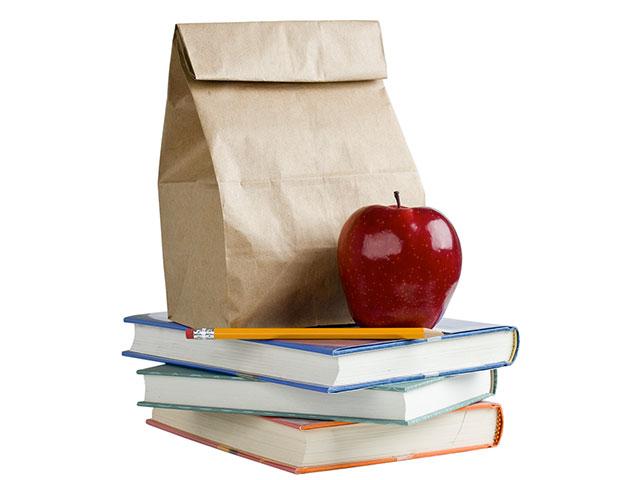When it comes to school lunches, there's no doubt the healthiest option is food from home. Homemade food, that is, NOT the awful commercialized, convenience foods lining the grocery store shelves that are marketed for school lunches. The chips, bars, drinks and prepared meals: avoid them like the plague! They are loaded with:
- high fructose corn syrup and other sugars
- trans fats and other inflammatory fats like soybean oil
- refined carbohydrates like enriched flour
- chemical additives such as MSG
Your child will eat about twenty lunches every month at school. That's a lot. So it's important that he or she gets the right nutrition. Sadly, that might not happen if they eat what the school provides. Although schools tend to portray their lunches as healthy, too often they are far less so than what we are led to believe.
The kids like school offerings such as pizza, hot dog and tacos, but these foods are highly processed and therefore unhealthy. Even the fruits and vegetables that are part of the school lunch are canned, which means they are missing the vitamins and minerals in fresh or previously frozen varieties.
Nevertheless, if your child is forced to eat only what the school provides (as mine were) then at least advise your child what to choose when they're going through the lunch line. Will they take your advice? Well, that's another story.
Lunch Line Tips:
- Drink only water: And lots of it. Too many Americans of all ages are chronically dehydrated, which can lead to overeating, believe it or not, and a whole host of other issues. Fruit juices, sports drinks and energy drinks are basically sugar water and should be avoided in and out of school. It may surprise you, but many nutritionists say when it comes to milk, even elementary school students no longer benefit from it. It contains its own sugar (lactose), especially skim milk and low fat milk. Chocolate or strawberry flavored milk is has way too much added sugar.
- Eat Lots of Vegetables: advise your child to eat as many vegetables as he or she can handle. Nutritionists say the healthiest diets are ones that are plant based. When it comes to things that grow, vegetables have a lower sugar output than fruits or grains, which should be consumed in moderation. When it comes to vegetables, a salad and other fresh greens top the list, while starchy vegetables such as potatoes, corn and peas are close to the bottom.
- Fill Up on Protein: Tell your child it's very important to have at least one serving of protein such as chicken, beef, fish or pork. Your child should not eat cured meats, such as "deli" meats, because they are usually processed with harmful nitrates and nitrites. (If we purchase deli meats from the grocery store, we must be sure it says "Uncured, No Nitrates or Nitrites" on the label. But don't be surprised if your market does not sell them.) Beans, nuts, cheese, eggs and yogurt are also good sources of protein but make sure it's plain yogurt, because the flavored ones are packed with sugar!
- Fruit is OK: In moderation. Teach your children to eat only whole fruits, not fruit by-products like those processed fruit snacks, fruit leathers and so forth, which are loaded with sugar. Don't be fooled by labels that say "No Sugar Added" because they already contain a horrendous amount of concentrated fructose, which is the kind of sugar naturally found in fruit. The only kind of fruit we should eat is the kind that has fiber, also known as the "meat" or "pulp" of the fruit, which slows down the absorption on the fructose.
- Eat Only One Serving of Grain: Teach your children that grains such as wheat, corn and rice are carbohydrates and your body responds to them much like it does like sugar. If your child is old enough, he or she might be able to comprehend that carbohydrates raise the hormone insulin that can cause them to feel tired after lunch. Although carbohydrates are a good source of energy, they should be eaten sparingly. Whole grain is best, but often not available at school.
- No Sugar: We can only hope and pray our kids will have enough self-control to avoid sweets and/or that the school places limits on how much a child can eat.
When it comes to packing your child's lunch, an insulated lunch box/bag works best so you can fill it with cold items such as vegetables and salads, plain yogurt with berries (the lowest sugar fruits), eggs, home-cooked meat, cheese chunks and so on without the food spoiling.
Kids love wraps, and you can buy healthy coconut wraps or sprouted grain wraps at some grocery stores. Spread some homemade hummus on the wrap, add cheese, lettuce and shredded red bell pepper. Roll it up tightly and slice it into bite-sized pieces.
If you want to make a sandwich for your child make sure you choose sprouted organic bread, preferably thinly sliced.
Roast a chicken on Sunday to send with your child the days following. Nuts (preferably raw), carrots, celery with almond butter, canned tuna with avocado and tomato are also healthy choices.










